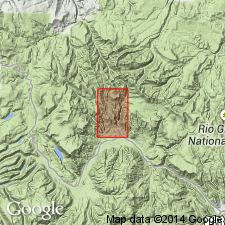
- Usage in publication:
-
- Mammoth Mountain rhyolite*
- Modifications:
-
- Original reference
- Dominant lithology:
-
- Rhyolite
- AAPG geologic province:
-
- San Juan Mountains province
Summary:
Mammoth Mountain rhyolite of Piedra group of Potosi volcanic series. A single thick rhyolite flow of rather uniform character, at base of Piedra group of Potosi volcanic series in northeastern part of Creede area and in mountains to east and northeast. Has been followed to east as far as Bellows Creek, but not recognized to west, south, or north of Creede Area. Wedges out in upper drainage basin of Nelson Creek. Thickness 0 to 1,000 feet. Overlain by rhyolite tuff. Age is Miocene.
Named from Mammoth Mountain, [northeast of North Creede, in NW/4 sec. 20, T. 42 N., R. 1 E., Lat. 37 deg. 52 min. 46 sec. N., Long. 106 deg. 54 min. 09 sec. W., San Luis Peak 7.5-min quadrangle, Mineral Co.], Creede district, southwestern CO.
Source: US geologic names lexicon (USGS Bull. 896, p. 1275).
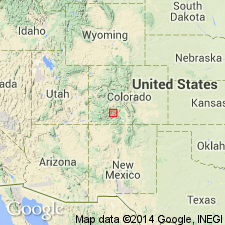
- Usage in publication:
-
- Mammoth Mountain Rhyolite*
- Modifications:
-
- Revised
- Dominant lithology:
-
- Rhyolite
- Quartz latite
- AAPG geologic province:
-
- San Juan Mountains province
Summary:
Mammoth Mountain Rhyolite. Revised in Creede area, Mineral County, Colorado (San Juan Mountain province) to include Mammoth Mountain Rhyolite as defined by Emmons and Larsen (1923), the overlying soft tuffs of Emmons and Larsen (1923), and all equivalent rocks, which together form a composite ash-flow sheet. Composition of the ash-flow tuffs range from rhyolite to quartz latite. Is a widespread unit recognized as far as 15 miles southeast, 10 miles southwest, and 18 miles south of Creede in the central San Juan Mountains. Is absent along Continental Divide north of Creede where the mountainous terrain stood above the level of accumulation. Is as much as 2,000 feet thick; over most areas is 500 to 1,000 feet thick. As redefined, ranges from a crystal-poor welded ash-flow tuff, with 5 to 10 percent phenocrysts, to a crystal-rich welded ash-flow tuff, with 30 to 60 percent phenocrysts. Plagioclase phenocrysts are predominant; sanidine phenocrysts common in crystal-poor rocks, but absent in most of the crystal-rich phase; biotite is the most prevalent mafic phenocryst. Age is middle and late Tertiary. Thought to be younger than Farmers Creek Rhyolite and older than Wason Park Rhyolite, and of the same general age as the Huerto Formation.
Source: Modified from GNU records (USGS DDS-6; Denver GNULEX).
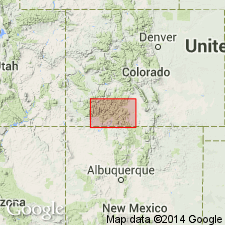
- Usage in publication:
-
- Mammoth Mountain Tuff*
- Modifications:
-
- Age modified
- AAPG geologic province:
-
- San Juan Mountains province
Summary:
Age changed from Oligocene --to-- late Oligocene.
Source: Changes in stratigraphic nomenclature, 1974 (USGS Bull. 1405-A, p. A12-A13).
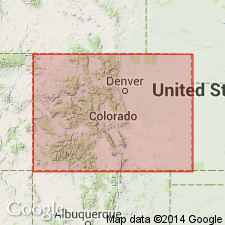
- Usage in publication:
-
- Mammoth Mountain Tuff*
- Modifications:
-
- Age modified
- Areal extent
- AAPG geologic province:
-
- San Juan Mountains province
Summary:
Mammoth Mountain Tuff. Is of zoned rhyolite to quartz latite composition. Had an estimated volume of 100 to 500 cubic km. Areal extent in southwestern Colorado shown (see fig. 19); present in Hinsdale County, Colorado (San Juan Mountain province). Source unknown. Indirect evidence suggests subsidence took place during eruption of Mammoth Mountain, but postulated caldera has been destroyed by the Creede caldera. Early episodic pyroclastic eruptions became pulsating and nearly continuous. Most of the flows are coherent, dense tuff that shows obscure compound cooling. Accumulated in the moat of the resurgent Bachelor caldera. Wedges out or is absent over top of resurgent core of Bachelor caldera. Remnants are preserved on the Continental Divide south of Creede. Age is late Oligocene (26.7 Ma).
Source: Modified from GNU records (USGS DDS-6; Denver GNULEX).
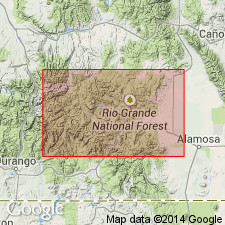
- Usage in publication:
-
- Mammoth Mountain unit*
- Mammoth Mountain member
- Modifications:
-
- Revised
- AAPG geologic province:
-
- San Juan Mountains province
Summary:
Pg. 334; see also Lipman, P.W., and Sawyer, D.A., 1988, Prelim. geol. San Luis Peak quadrangle and adj. areas San Juan volcanic field, southwestern CO, USGS Open-File Rpt. 88-359, p. 7-8, geol. map (scale 1:24,000).
Mammoth Mountain member (informal) of Carpenter Ridge Tuff. Previously considered a discrete ash-flow sheet (Ratte and Steven, 1967; Steven and others, 1974). Restudy of Creede area, Mineral County, Colorado, has shown that previously mapped boundary between lithologies of Mammoth Mountain Tuff and Bachelor Mountain Member of Carpenter Ridge Tuff, within the source Bachelor caldera, is an alteration boundary that lacks evidence for a major cooling break. Mammoth Mountain is now used informally to designate phenocryst-rich silicic dacite in upper part of compositionally zoned Carpenter Ridge ash-flow sheet. Older than Wason Park Tuff. Age is Oligocene (27.35 Ma).
[GNC remark (February 2019): subsequent publications by the lead author (e.g., Lipman, P.W., 2000, GSA Spec. Paper 346, p. 9-71; Lipman, P.W., 2007, USGS Geol. Inv. Ser. Map I-2799, 34 p., scale 1:50,000) indicate his intention was not to abandon the formation-ranked Mammoth Mountain Tuff as a formal unit, but to reduce its rank to a formal member of the Carpenter Ridge Tuff and restrict it to the phenocryst-rich silicic dacite. The phenocryst-poor intracaldera rhyolitic tuffs are reassigned to the Bachelor Mountain.
[GNU records (USGS DDS-6; Denver GNULEX, December 5, 1988) indicate this unit was adopted by the USGS as Mammoth Mountain unit (informal) in Carpenter Ridge Tuff.]
Source: GNU records (USGS DDS-6; Denver GNULEX).
For more information, please contact Nancy Stamm, Geologic Names Committee Secretary.
Asterisk (*) indicates published by U.S. Geological Survey authors.
"No current usage" (†) implies that a name has been abandoned or has fallen into disuse. Former usage and, if known, replacement name given in parentheses ( ).
Slash (/) indicates name conflicts with nomenclatural guidelines (CSN, 1933; ACSN, 1961, 1970; NACSN, 1983, 2005, 2021). May be explained within brackets ([ ]).

